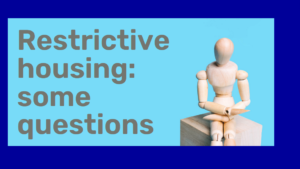A recent segment of the 1A program on public radio addressed restrictive housing (aka Special Housing Unit or SHU; aka solitary confinement). (June 27, 2023, https://the1a.org/segments/the-problem-with-solitary-confinement-in-the-u-s/) The panelists included a journalist and two advocates for the rights of people who are incarcerated.
 The speakers made valid points about how bad it is for people to be isolated from others, how restrictive housing is not being used appropriately in some locations, and how it has other negative effects. It’s good that the program is raising awareness, but I wish they’d go deeper. A better focus is to look at what progress individual agencies have made and what could help other agencies move forward, too.
The speakers made valid points about how bad it is for people to be isolated from others, how restrictive housing is not being used appropriately in some locations, and how it has other negative effects. It’s good that the program is raising awareness, but I wish they’d go deeper. A better focus is to look at what progress individual agencies have made and what could help other agencies move forward, too.
First, it’s important to acknowledge the valid need to separate some people from others in the secure facility. As a retired warden pointed out in a sound bite, some people who are confined are in fact highly dangerous to staff and other residents. If someone hasn’t worked in maximum security, he said, it’s unlikely they can understand the danger that some individuals genuinely pose.
Accreditation standards from the American Correctional Association provide an outline for the appropriate use of restrictive housing. Policies and practices from agencies with solid SHU management also provide a model. Being assigned there should take a clear decision-making process. The length of time someone is housed there should be policy-based. There should be scheduled reviews of the resident’s behavior and mental health indicators. There should be a defined process for moving the person toward release from the unit, based on policy and their own behavior.
It’s also important to understand that every state corrections agency is unique, as is the correctional system in every county or city. Some agencies have developed thoughtful, evidence-based approaches and are following them. Other agencies may have been unable to change their practices appreciably in the short term, but have begun their work toward change. Some may not have made it a high priority relative to other issues they’re addressing. There’s no doubt that some agencies or individual facilities would be improved if they took action on their use of segregated housing.
Change and progress come when agency leaders and staff have the space to say, “Why do we do it this way? What could happen if we change this bit here?”
Surfacing Key Elements
To understand what’s actually happening at the agency and facility level, it would be useful to interview leadership and the people who led agencies’ change process hands-on.
- Who was involved?
- How did they approach it?
- What help did they need?
- What conceptual challenges did they encounter, and how did they work through them?
Once the changes were ready to implement, how did it go? What’s the status today? What do their metrics say about how it’s working and what’s different?
And, importantly, what did they learn? What would they advise other agencies to do when examining this area and innovating their policies and operations?
Common obstacles to change include the need for clear and refreshed policy, the momentum of past practice, a culture that resists change (especially when staff safety is a factor), the need for a committed person or team to lead the change initiative and the resources to do so, and the challenges of effective supervision and oversight after implementation. Agencies also may be limited in some ways by their physical plant, technology, and staffing needs.
Perspectives
In this pre-recorded program, there was no opportunity for someone with a background in corrections to be part of the live discussion. Someone could point out that it’s hard to prove a negative—how many injuries and deaths might have happened if certain inmates were not placed in an SHU? It is not an exaggeration to suggest that lives have been saved.
The primary task for a corrections agency, as always, is using the staff, facilities, and funding they have to keep their facilities safe.
Correctional agencies are working on behalf of us all who are community members and taxpayers. By understanding more about the issues their staff and leaders are dealing with, we can be better advocates in support of continued progress in our state and local correctional systems.